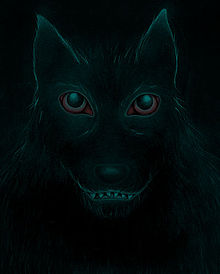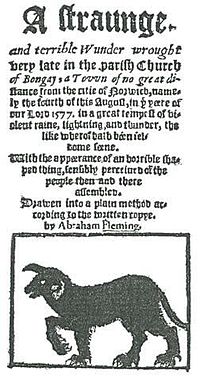- Black Shuck
-
 Artist's impression of the Black Shuck. Commonly described features include large red eyes, bared teeth and shaggy black fur.[1]
Artist's impression of the Black Shuck. Commonly described features include large red eyes, bared teeth and shaggy black fur.[1]
Black Shuck, Old Shuck, Old Shock or simply Shuck is the name given to a ghostly black dog which is said to roam the coastline and countryside of East Anglia. Accounts of the animal form part of the folklore of Norfolk, Suffolk, The Fens and Essex.[2][3]
The name Shuck may derive from the Old English word scucca meaning "demon", or possibly from the local dialect word shucky meaning "shaggy" or "hairy".[4]
Black Shuck is one of many ghostly black dogs recorded across the British Isles.[5] Sometimes recorded as an omen of death, sometimes a more companionable animal, it is classified as a cryptid, and there are varying accounts of the animal's appearance.[4][6] Writing in 1877, Walter Rye stated that Shuck was "the most curious of our local apparitions, as they are no doubt varieties of the same animal.[7]
Its alleged appearance in 1577 at Bungay and Blythburgh is a particularly famous account of the beast, and images of black sinister dogs have become part of the iconography of the area.[1]
Folklore
For centuries, inhabitants of England have told tales of a large black dog with malevolent flaming eyes (or in some variants of the legend a single eye) that are red or alternatively green. They are described as being 'like saucers'. According to reports, the beast varies in size and stature from that of simply a large dog to being the size of a calf or even a horse.[1][6] Sometimes Black Shuck is recorded as having appeared headless, and at other times as floating on a carpet of mist.
According to folklore, the spectre haunts the landscapes of East Anglia, primarily coastline, graveyards, sideroads, crossroads, bodies of water and dark forests.[4] W. A. Dutt, in his 1901 Highways & Byways in East Anglia describes the creature thus:
He takes the form of a huge black dog, and prowls along dark lanes and lonesome field footpaths, where, although his howling makes the hearer's blood run cold, his footfalls make no sound. You may know him at once, should you see him, by his fiery eye; he has but one, and that, like the Cyclops', is in the middle of his head. But such an encounter might bring you the worst of luck: it is even said that to meet him is to be warned that your death will occur before the end of the year. So you will do well to shut your eyes if you hear him howling shut them even if you are uncertain whether it is the dog fiend or the voice of the wind you hear. Should you never set eyes on our Norfolk Snarleyow you may perhaps doubt his existence, and, like other learned folks, tell us that his story is nothing but the old Scandinavian myth of the black hound of Odin, brought to us by the Vikings who long ago settled down on the Norfolk coast.[8]It is Dutt's description which gave rise to one misnomer for Black Shuck as "Old Snarleyow"; in the context of his description it is a comparative to Frederick Marryat's 1837 novel Snarleyyow, or the Dog Fiend, which tells the tale of a troublesome ship's dog.[9]
Dr Simon Sherwood suggests that the earliest surviving description of devilish black hounds is an account of an incident recorded in the Peterborough Abbey recorded in the Peterborough Chronicle (one of the Anglo-Saxon Chronicles) around 1127. This account also appears to describe the Europe-wide phenomenon of a Wild Hunt:
Let no-one be surprised at the truth of what we are about to relate, for it was common knowledge throughout the whole country that immediately after [Abbot Henry of Poitou's arrival at Peterborough Abbey] - it was the Sunday when they sing Exurge Quare - many men both saw and heard a great number of huntsmen hunting. The huntsmen were black, huge and hideous, and rode on black horses and on black he-goats and their hounds were jet black with eyes like saucers and horrible. This was seen in the very deer park of the town of Peterborough and in all the woods that stretch from that same town to Stamford, and in the night the monks heard them sounding and winding their horns. Reliable witnesses who kept watch in the night declared that there might well have been as many as twenty or thirty of them winding their horns as near they could tell. This was seen and heard from the time of his arrival all through Lent and right up to Easter."[10][6]According to some legends, the dog's appearance bodes ill to the beholder, for example in the Maldon and Dengie area of Essex, the most southerly point of sightings, seeing Black Shuck means the observer's almost immediate death. However, more often than not, stories tell of Black Shuck terrifying his victims, but leaving them alone to continue living normal lives; in some cases it has supposedly happened before close relatives to the observer die or become ill.
By contrast, in other tales the animal is regarded as relatively benign and said to accompany women on their way home in the role of protector rather than a portent of ill omen.[11] Some black dogs have been said to help lost travellers find their way home and are more often helpful than threatening; Sherwood notes that benign accounts of the dog become more regular towards the end of the 19th and throughout the 20th centuries.[6]
Appearance in Bungay and Blythburgh
 Title page of the account of Rev. Abraham Fleming's account of the appearance of the ghostly black dog "Black Shuck" at the church of Bungay, Suffolk: "A straunge, and terrible wunder wrought very late in the parish church of Bongay: a town of no great distance from the citie of Norwich, namely the fourth of this August, in ye yeere of our Lord 1577".
Title page of the account of Rev. Abraham Fleming's account of the appearance of the ghostly black dog "Black Shuck" at the church of Bungay, Suffolk: "A straunge, and terrible wunder wrought very late in the parish church of Bongay: a town of no great distance from the citie of Norwich, namely the fourth of this August, in ye yeere of our Lord 1577".
One of the most notable reports of Black Shuck is of his appearance at the churches of Bungay and Blythburgh in Suffolk. On 4 August 1577, at Blythburgh, Black Shuck is said to have burst in through the church doors to a clap of thunder. He ran up the nave, past a large congregation, killing a man and boy and causing the church steeple to collapse through the roof. As the dog left, he left scorch marks on the north door which can be seen at the church to this day.[12]
The encounter on the same day at Bungay was described in A Straunge and Terrible Wunder by the Reverend Abraham Fleming in 1577:
This black dog, or the divel in such a linenesse (God hee knoweth al who worketh all,) running all along down the body of the church with great swiftnesse, and incredible haste, among the people, in a visible fourm and shape, passed between two persons, as they were kneeling uppon their knees, and occupied in prayer as it seemed, wrung the necks of them bothe at one instant clene backward, in somuch that even at a mome[n]t where they kneeled, they stra[n]gely dyed.[13]It must be noted that Adams was a clergyman from London, and therefore probably only published his account based on exaggerated aural accounts. Other local accounts attribute the event to the Devil (Abrahams calls the animal "the Divel in such a likeness". The scorch marks on the door are referred to by the locals as "the devil’s fingerprints", and the event is remembered in this verse:
All down the church in midst of fire, the hellish monster flew, and, passing onward to the quire, he many people slew.[14]Dr David Waldron and Christopher Reeve suggest that a fierce electrical storm recorded by contemporary accounts on that date, coupled with the trauma of the ongoing Reformation may have led to the accounts entering folklore.[15]
References
- ^ a b c Jennifer Westwood and Jacqueline Simpson, The Lore of the Land: A Guide to England's Legends, from Spring-heeled Jack to the Witches of Warboys, Penguin, 2005, pp.687-688
- ^ Jennifer Westwood, Jacqueline Simpson, Sophia Kingshill, The Penguin Book of Ghosts, Penguin, 2008
- ^ Enid Porter, Cambridgeshire customs and folklore: with Fenland material provided, Taylor & Francis, 1969, p.53
- ^ a b c George M. Eberhart, Mysterious Creatures: A Guide to Cryptozoology: Volume 1, 2002, p. 63
- ^ Country Life: Volume 174, 1983
- ^ a b c d Dr Simon Sherwood, Apparitions of Black Dogs, University of Northampton Psychology Department, 2008
- ^ Walter Rye, The Norfolk antiquarian miscellany, Miller and Leavins, 1877
- ^ W. A. Dutt: Highways & Byways in East Anglia, MacMillan, 1901, p.216
- ^ Mike Burgess, Moddey Dhoo & Snarleyow, Hidden East Anglia, 2005
- ^ G McEwan, Mystery Animals of Britain and Ireland, Robert Hale 1986, 122
- ^ The Tollesbury Midwife
- ^ John Seymour, The companion guide to East Anglia, Collins, 1977
- ^ Abraham Adams, A strange, and terrible wunder, London 1577, reprinted 1948
- ^ Enid Porter, The folklore of East Anglia, Volume 1974, Part 2
- ^ Dr. David Waldron and Christopher Reeve, Shock! The Black Dog of Bungay: A Case Study in Folklore, Hidden Design Ltd, 2010
Barguest (Yorkshire) • Black Shuck (East Anglia) • Church Grim (England) • Dip (Catalonia) • Gytrash (Northern England) • Gwyllgi (Wales)Categories:- English legendary creatures
- History of Essex
- History of Norfolk
- History of Suffolk
- Mythological dogs
- Norfolk folklore
- Essex folklore
- Suffolk folklore
Wikimedia Foundation. 2010.
